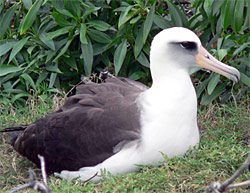Tsunami displaces thousands of albatross chicks
March 14, 2011
We’re still reeling from the news of the huge earthquake and tsunami that hit Japan on Friday and whose aftereffects continue to threaten Japan’s people.
As if the human catastrophe weren’t enough, the tsunami that crossed the Pacific Ocean has swept over most of Midway Atoll, where it has washed away tens of thousands of albatross chicks and buried many petrels in their burrows.
Pete Leary, a U.S. Fish and Wildlife Service biologist on Midway, has details and photos on his blog.
The tsunami smashed boats and a few houses in Hawaii and damaged boats and harbors in California. As it passed Midway, waves of about 5 feet swept onto both of Midway’s main islands (Sand Island and Eastern Island). None of the 67 people on the island were injured, Leary reported. They were on the third floor of a barracks, whereas the atoll’s approximately 2 million seabirds—Laysan Albatrosses, Bonin Petrels, and Black-footed Albatrosses were at ground level or below.
After the tsunami passed, Leary and the other staff and visitors scrambled to assess the damage and rescue chicks and adults that had been swept out to sea, strained through low-growing shrubs, or buried in the sand. Hundreds of fish and a few sea turtles had been swept onto the middle of Eastern Island, Leary wrote. Fortunately, no Hawaiian monk seals or Laysan Ducks appeared to have been injured.
The tsunami is a saddening setback for Midway, which just last week celebrated the oldest-known albatross, Wisdom, a Laysan Albatross that at 60 years old is still raising chicks; and in mid-January reported the first-ever hatching of an endangered Short-tailed Albatross chick on U.S. soil. That chick was washed about 40 yards off its nest but survived, Leary wrote on his blog.
The U.S. Fish and Wildlife Pacific region has been posting updates on its Twitter feed (directing people to Leary’s blog for details).
Kure Atoll, another island with nesting albatrosses that is about 60 miles from Midway, also was struck and many Black-footed Albatrosses washed away, according to a Facebook update from the Kure Atoll Conservancy.
Many thanks to Leary for providing detailed updates during a very trying situation. Our warmest thoughts go out to all the victims of this tragedy.
For more about the seabirds of Midway Atoll, see Albatross Island in last summer’s Living Bird magazine.

All About Birds
is a free resource
Available for everyone,
funded by donors like you
American Kestrel by Blair Dudeck / Macaulay Library
